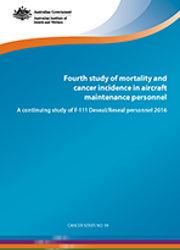Summary
From 1974 to 2000, the Royal Australian Air Force (RAAF) put in place formal Deseal/Reseal (DSRS) programs, in addition to informal repair methods, to correct fuel leaks in Australia's F-111 fleet of aircraft. These programs were undertaken at RAAF Base Amberley in Queensland, and were suspended in early 2000 due to health concerns among DSRS personnel. A series of inquiries, investigations and scientific studies were commenced to determine the extent and impact of those health concerns.
As part of those investigations, the Mortality and Cancer Incidence Study (MCIS) was started to answer the following research question: did RAAF personnel involved either directly or indirectly in the F-111 DSRS maintenance programs (the DSRS-exposed Study Population) experience higher levels of mortality or cancer incidence compared with two groups of non-exposed RAAF personnel (the Comparison populations) – the RAAF Base Amberley (non-technical) Comparison Population and the RAAF Base Richmond (technical) Comparison Population?
This report presents the findings of the fourth iteration of that study (the 4th MCIS). The Study Population and Comparison populations were modified from those in the 3rd MCIS to include new information about exposure arising from an administrative assessment process (Tier classification). This process defined DSRS-exposure levels (Tiers) based on the type, time period and duration of DSRS-related activities. Including these data in the 4th MCIS has improved both the accuracy and the completeness of the Study Population. For continuity, a supplementary analysis (the 3rd MCIS Update) was undertaken using 3rd MCIS data. The data presented refer to male personnel only.
Key findings
The results of the 4th MCIS show that involvement in the DSRS programs at RAAF Base Amberley was associated with a statistically significant 20–30% increase in the rate of cancer diagnosis, compared with both Comparison populations.
Involvement in the DSRS programs was also associated with a statistically significant 27% decrease in mortality compared with the Amberley Comparison Population, and a non-significant 6% decrease compared with the Richmond Comparison Population.
The key finding of increased rates of cancer incidence in the Study Population is tempered by the presence of methodological limitations that cannot be adjusted for in the study method. These relate to the incompleteness and voluntary selection of the Study Population, the unknown risk factor profiles and differing health surveillance experience of the Study and Comparison populations, and the heterogeneous nature of the DSRS exposure.
The combined effect of these limitations cannot be quantified. Evidence of this effect is observed in the elevated incidence of most cancer sites/types among the Study Population. This finding is unlikely to be related to a single set of exposures and is consistent with the limitations known to be present in this study.
Updating this study with an additional 10–15 years of cancer incidence data may improve the precision of the point estimates and provide greater statistical strength to the findings, particularly in relation to specific cancer sites/types. However, the limitations described above will remain, and must be considered when interpreting future results.
Preliminary material: Acknowledgments; Abbreviations
1 Introduction
- Purpose and structure
- F-111 fleet and maintenance programs
- Health concerns and inquiries
- Studies into health outcomes
2 Methods
- Data sources
- Constructing the data sets from available data
- Data linkage and privacy
- Comparative analysis methods
- Understanding the results and key findings of the comparative analysis
3 Fourth MCIS: results
- Cancer incidence
- Mortality
- Comparison with Australian male population
4 Third MCIS Update: results
- Cancer incidence
- Mortality
5 Discussion
- Cancer incidence
- Mortality
- Limitations
- Potential for further work
6 Conclusions
Appendixes:
Appendix A: Methodology and technical notes
Appendix B: Data sources and classifications
Appendix C: Detailed results of the 4th MCIS
Appendix D: Detailed results of the 3rd MCIS Update
Appendix E: Comparison between Mortality and Cancer Incidence Studies
Appendix F: Firefighters
End matter: Glossary; References; List of tables; List of figures; List of boxes



